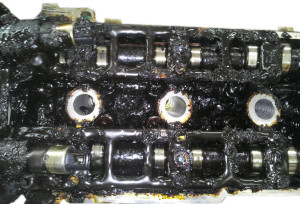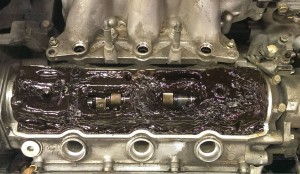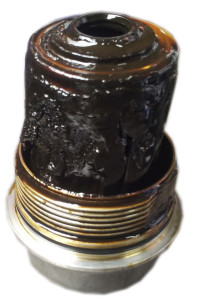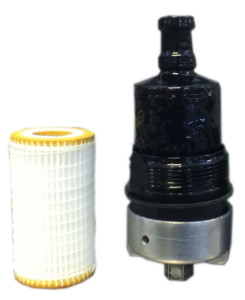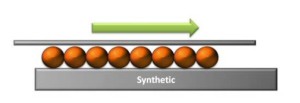Motor oil sludge
Does your engine have a buildup of motor oil sludge?
If so, read this post to find out what causes it and what to do about it.
This article is just one in a series. If you’d like to know more about oil click on the links below.
Chrysler’s 3.5-liter engine has oil sludge issues
High mileage oil and oil filters
Synthetic oil versus conventional oil
I volunteer in a lot of automotive forums and I see lots of wanna-be mechanics giving some really bad advice, especially when it comes to motor oil sludge buildup. One active participant on Yahoo Answers rants about VALVOLINE motor as the #1 villain. His standard line is that “Valvoline is made using the wax reduction method and contains high levels of ASH that’s why it’s junk.” Baloney. BTW, he makes the ASH point by noting that the parent company for Valvoline is ASHLAND OIL. But none of what he says is true. Not one word.
First, unless a synthetic oil is made from natural gas, it’s refined from traditional crude. Then it’s refined to reduce the natural paraffin (wax). Paraffin solidifies and is more viscous when cold and is much harder to pump. So oil companies reduce the paraffin levels and add pour-point depressants to prevent the paraffin molecules from coagulating and thickening. To reduce the actual paraffin content in motor oil, companies have used many different methods like catalytic cracking, hydro-isomerization and catalytic dewaxing, or by polymerization processes — which would qualify them as “man made,” i.e., synthesized. Yes, technically speaking, those are all wax reduction methods. But when you use these highly refined processes, you’re reducing the paraffin levels to the point a Group III base oil and can be officially called “synthetic.” Formerly, only true polyalphaolefin (PAO) oil could be called synthetic Group IV. PAO oil is made using natural gas and other base materials using a chemical reaction to produce an oil with uniform molecule size and absolutely no paffafin.
Just like making soup
Throw a gallon of water and vegetables in a pot and add water and heat. Pretty soon you’ll have vegetable soup. The vegetables and water each have a different size molecules. But it you keep the heating going past that point, you’ll boil off the water and have far more concentrated and thicker soup. Keep heating and you’ll wind up with sludge. The same thing can happen to motor oil.
The biggest misunderstanding about motor oil is that people think it’s a single type of molecule. All multi-viscosity oils, even true Group IV synthetics contain a “soup” of base oils and additives. The recipes are secret, but here’s an example. To achieve a 5W-20 oil, an oil company can use a Group IV 5-weight synthetic along with viscosity index improvers..
If you then do a lot of cold starts where you have a rich mixture and combine it with short trips, you have all the makings of sludge. Because all engines have a certain amount of blowby–gasses that seem past the piston rings, you get fuel and water in the crankcase. The water gets mixed into the oil and oxidizes it at a faster rate. And it combines with combustion gasses to form acids. The water and acids deplete the anti-oxidants, acid neutralizers, dispersants, and detergents faster. So you’re left with oxidized oil, soot, and acids. With little to no disperant additive left, the normal soot and combustion byproducts that would normally be kept in suspension and carried off the oil filter are now settling out of suspension and forming sludge deposits. Add engine heat to the mixture to boil off any remaining water and now you’ve got thick pudding that hardens over time.
Combustion byproducts
For every 100 gallons of gasoline, you produce 90-120 gallons of water, 3-10 gallons of unburned gasoline, .5-3-lbs. of soot (ash) and carbon, .25-1-lb. of varnish, and 1-4-lbs. of sulfuric and nitric acid.
Ash is the result of burned anti-wear additives. The bulk of the ash goes out through the tailpipe since that’s where the burning takes place. But a small amount gets into the crankcase from blowby. Ash is filtered out of the oil by the oil filter. If you use a high quality oil filter and change it on time, you will NOT accumulate ash in the oil pan. Even if the filter is full and has gone into bypass mode, ASH is NOT a major component of sludge. As I said earlier, sludge is caused by moisture and oil breakdown. It is NOT caused by wax, even though our Yahoo wanna-be claims.
Since even new engine produce blow-by (gasses that seep past the piston rings and into the crankcase) these combustion byproducts are going to end up in your engine’s crankcase.
The acids are neutralized by the engine oil’s additive package. The soot and carbon are suspended in the oil with suspension and dispersant additives and the crud is carried off to the oil filter. But if you run the oil too long, it reaches a breaking point where the acid neutralizing, suspension, anti-corrosion, anti-oxidation, and dispersant additives are depleted and the crud settles in low point around the engine. Plus, running too long between oil and filter changes means the oil filter itself becomes full and goes into “bypass” mode where it no longer filters the oil. This is the beginning of motor oil sludge–excessive buildup of combustion contaminant. It is NOT caused by wax accumulation and ash, as is so often reported by nit-wit wanna be mechanics.
Viscosity Improver Breakdown
Multi-viscosity oil contains a polymeric Viscosity Index Improver. This special additive is a coiled molecule that uncoils when heated. It literally becomes larger and acts as a thickening agent, somewhat like adding flour to gravy. Unlike flour, however, as the molecule cools, it returns to its smaller shape. Unfortunately, the VII is susceptible to shear forces. When subjected to extreme pressure or shear, the molecule can be sliced apart. It then become two smaller molecules. As the smaller molecule is subjected to more and more shear, it begins to breakdown and oxidize, at which point it start settling out of the oil. Hopefully it’s captured by the filter. If it isn’t, it settles into low spots in the engine adding to the sludge problem.
Engine design affects sludge
Let’s stick with our soup analogy. If you cook the soup with a lid on the pan, you know that you’ll lose less water. Well, engine crankcases accumulate blow-by gasses—gasses that seep past the piston rings. In the days before emissions standards, car makers simply vented these gasses to the atmosphere. Today, those gasses are sucked out of the crankcase and re-burned in the engine. The copy on the beat that controls the flow of these gasses is the positive crankcase ventilation (PCV) valve. So really, the PCV valve is like a vent in the lid of your soup pot.
The early PCV valves had a large opening to vent as much blow-by as possible. But as engine parts whip into the oil bath, they create a fine oil mist. Car makers discovered that too much PCV sucked the oil mist out of the crankcase and into the intake manifold where it was burned. That INCREASED emissions and affected the life of the catalytic converter. In addition, the extra oil mist created carbon deposits on the valves and piston heads. So car makers reduced PCV flow. Can you see where this is going?
When PCV flow is reduced too far, that engine will suffer sludge buildup through no fault of the owner. Some Toyota, Audi, and VW, engines had this problem in the early 2000’s. The car makers blamed the owners for not changing the oil on time. But many owners were able to provide proof of oil changes. Lawsuit ensued.
The right oil and the right oil change intervals.
I wrote an article on when to change your oil. The link is at the top of this page. READ IT. Because way too many wanna-be car experts spout off bad information by encouraging people to extend their oil drain intervals. Oil life is based on far more than just the number of miles you drive. Oil degrades based on the number of cold starts, engine RPMs, and the load placed on it. Every cold start introduces raw fuel and water into the oil. That depletes the anti-corrosion inhibitors, increases the level of soot.
Finally, it’s the specs.
Please read my article on Choosing the right motor oil, because I’ve already explain the concept of oil specifications.
Then take a look at this Audi lawsuit and see how those specs and crankcase ventilation go hand in hand. Click on the image to download the PDF
“Most people relate the word paraffin to candle wax. This is a correct association, BUT one of the most incorrect and widely circulated misconceptions about sludge is that it forms more easily in paraffin-based motor oils. This couldn’t be further from the truth. All major motor oils, in fact, are formulated using a paraffin-based crude oil. Naphthenic-based crude oils are actually more likely to form sludge in an engine than oils formulated with paraffin-based crude oils. This is due to the higher breakdown resistance of paraffin-based crude oils. —Pennzoil Motor Oil Company“
For an undated post on engine oil life, read this
© 2012 Rick Muscoplat
Posted on by Rick Muscoplat
